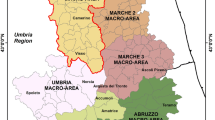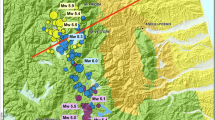Abstract
An extensive application of seismic microzoning studies requires the definition of specific proxies to allow local practitioners to quantify litho-stratigraphical amplification phenomena on the basis of procedures simple enough to allow a widespread application. To be effective, these tools should be specialized to the litho-stratigraphical configurations representative of the study area. A procedure is here described for providing such a tool on the basis of extensive numerical simulations taking advantage of geological/geotechnical information made available by regional/national Authorities. This procedure is quite general and could be applied in several contexts and, in particular, in developing countries low seismicity areas or where extensive accelerometric databases are lacking. As an example, an application of the above procedure developed on behalf of the Tuscany Regional Administration (in Central Italy) is presented.



Similar content being viewed by others
References
Albarello D, Gargani F (2010) Providing NEHRP soil classification from the direct interpretation of effective Rayleigh waves dispersion curves. Bull Seismol Soc Am 100:3284–3294. doi:10.1785/0120100052
Astroza M, Monge J (1991) Seismic microzones in the city of Santiago. Relating damage-geological unit. In: Proceedings of 4th international conference on seismic zonation, Stanford, California, August, vol III, pp 595–601
Bard PY (1994) Effects of surface geology on ground motion: recent results and remaining issues. In: Proceedings of 10th European conference on earthquake engineering, Vienna, vol 1, pp 305–323
Bard PY, Bouchon M (1985) The two-dimensional resonance of sediment-filled valleys. Bull Seismol Soc Am 75:519–541
Bardet JP, Ichii K, Lin CH (2000) EERA: a computer program for equivalent-linear earthquake site response analyses of layered soil deposits. Department of Civil Engineering, University of Southern California, Los Angeles
Bonnefoy-Claudet S, Cornou C, Bard PY, Cotton F, Moczo P, Kristek J, Fäh D (2006) H/V ratios: a tool for site effects evaluation. Results from 1-D noise simulations. Geophys J Int 167:827–837
Boore BM (2004) Estimating Vs30 (or NEHRP site classes) from shallow velocity models (Depths < 30 m). Bull Seismol Soc Am 94:591–597
Borcherdt RD (1994) Estimates of site-dependent response spectra for design (methodology and justification). Earthq Spectra 10:617–653
Borcherdt RD, Wentworth CM, Janssen A, Fumal T, Gibbs J (1991) Methodology for predictive GIS mapping of special study zones for strong ground shaking in San Francisco Bay Region. In: Proceedings of 4th international conference on seismic zonation, vol 3, pp 545–552
Building Seismic Safety Council (2003) NEHRP recommended provisions for seismic regulations for new buildings and other structures (FEMA 450), Part 1: provisions. Building Seismic Safety Council for the Federal Emergency Management Agency, Washington, DC
Castellaro S, Mulargia F (2009) Vs30 estimates using constrained H/V measurements. Bull Seismol Soc Am 99:761–773. doi:10.1785/0120080179
Castellaro S, Mulargia F, Rossi PL (2008) Vs30: proxy for seismic amplification? Seismol Res Lett 79:540–543
Corigliano M, Lai CG, Rota M, Strobbia CL (2012) ASCONA: automated selection of compatible natural accelerograms. Earthq Spectra 28:965–987
Cultrera G, Mucciarelli M, Parolai S (2011) The L’Aquila earthquake—a view of site effects and building behavior from temporary networks. Bull Earthq Eng 9:691–695
Darendeli MB (2001) Development of a new family of normalized modulus reduction and material damping curves. The University of Texas, Austin
Decree Law 77 (2009) Conversione in legge, con modificazioni, del decreto-legge 28 aprile 2009, n. 39, recante interventi urgenti in favore delle popolazioni colpite dagli eventi sismici nella regione Abruzzo nel mese di aprile 2009 e ulteriori interventi urgenti di protezione civile. (09G0088), Gazzetta Ufficiale n. 147 del 27 giugno 2009 (in Italian)
Eurocode 8, EC8 (2003) Draft prENV 1998-1 Jan 2003, Design of structures for earthquakes resistance. Part 1: general rules, seismic actions and rules for buildings (draft no 4). European Committee for Standardization, Brussels
Foti S, Parolai S, Albarello D, Picozzi M (2011) Application of surface wave methods for seismic site characterization. Surv Geophys 32:777–825. doi:10.1007/s10712-011-9134-2
Gallipoli MR, Mucciarelli M (2009) Comparison of site classification from Vs30, Vs10, and HVSR in Italy. Bull Seismol Soc Am 99:340–351. doi:10.1785/0120080083
Gorini A, Nicoletti M, Marsan P, Bianconi R, de Nardis R, Filippi L, Marcucci S, Palma F, Zambonelli E (2010) The Italian strong motion network. Bull Earthq Eng 8:1075–1090
Idriss IM, Sun JI (1992) Shake91: a computer program for conducting equivalent linear seismic response analysis of horizontally layered soil deposits. User’s guide. Center for Geotechnical Modeling, Civil Engineering Department, UC Davis, Davis
Iervolino I, Galasso C, Cosenza E (2009) REXEL: computer aided record selection for code-based seismic structural analysis. Bull Earthq Eng 8:339–362. doi:10.1007/s10518-009-9146-1
International Code Council Inc. (2000) International Building Code
Italian Building Code (2008) NTC08: Norme Tecniche per le Costruzioni. DM 14 gennaio 2008. Gazzetta Ufficiale, n. 29 del 4 febbraio 2008, Supplemento Ordinario n. 30. Istituto Poligrafico e Zecca dello Stato, Roma (in Italian) available online in the website www.cslp.it
Joyner WB, Fumal TE (1984) Use of measured shear-wave velocity for predicting geologic site effects on strong ground motion. In: Proceedings of 8th world conference on earthquake engineering, vol 2, pp 777–783
Kramer SL (1996) Geotechnical earthquake engineering. Prentice Hall, New York
Lang DH, Schwarz J (2006) Instrumental subsoil classification of Californian strong motion sites based on single-station measurements. In Proceedings of the 8th U.S. national conference of earthquake engineering, San Francisco, paper no. 120
Medvedev J (1962) Engineering seismology. Academia Nauk Press, Moscow
Midorikawa S (1987) Prediction of iso-seismal map in the Kanto Plain due to hypothetical earthquake. J Struct Eng ASCE 33B:43–48 (in Japanese)
Pacor F, Paolucci R, Luzi L, Sabetta F, Spinelli A, Gorini A, Nicoletti M, Marcucci S, Filippi L, Dolce M (2011) Overview of the Italian strong motion database ITACA. Bull Earthq Eng 9:1723–1739. doi:10.1007/s10518-011-9327-6
Pagani M, Marcellini A, Crespellani T, Martelli L, Tento A, Daminelli R (2006) Seismic microzonation regulations of the Emilia-Romagna Region (Italy). Third international symposium on the effects of surface geology on seismic motion, Grenoble, France, 30 August–1 September 2006
Paolucci R (2002) Amplification of earthquake ground motion by steep topographic irregularities. Earthq Eng Struct D 31:1831–1853. doi:10.1002/eqe.192
Pileggi D, Rossi D, Lunedei E, Albarello D (2011) Seismic characterization of rigid sites in the ITACA database by ambient vibration monitoring and geological surveys. Bull Earthq Eng 9:1839–1854. doi:10.1007/s10518-011-9292-0
Pitilakis K, Riga E, Anastasiadis A (2013) New code site classification, amplification factors and normalized response spectra based on a worldwide ground-motion database. Bull Earthq Eng 11:925–966
Puglia R, Albarello D, Gorini A, Luzi L, Marcucci S, Pacor F (2011) Extensive characterization of Italian accelerometric stations from single station ambient vibration measurements. Bull Earthq Eng 9:1839–1854. doi:10.1007/s10518-011-9305-z
Rathje EM, Kottke A (2013) Strata. Available online in the website http://nees.org/resources/strata
Rey J, Faccioli E, Bommer JJ (2002) Derivation of design soil coefficients (S) and response spectral shapes for Eurocode 8 using the European Strong-Motion Database. J Seismol 6:547–555
Rodriguez-Marek A, Bray JD, Abrahamson NA (2001) An empirical geotechnical seismic site response procedure. Earthq Spectra 17:65–87
Rota M, Zuccolo E, Taverna L, Corigliano M, Lai CG, Penna A (2012) Mesozonation of the Italian territory for the definition of real spectrum-compatible accelerograms. Bull Earthq Eng 10:1357–1375. doi:10.1007/s10518-012-9369-4
Rovida A, Camassi R, Gasperini P, Stucchi M (eds.) (2011) CPTI11, the 2011 version of the parametric catalogue of Italian earthquakes. Milano, Bologna, http://emidius.mi.ingv.it/CPTI. doi:10.6092/INGV.IT-CPTI11
Schnabel PB, Lysmer J, Seed HB (1972) SHAKE: a computer program for earthquake response analysis of horizontally layered sites. Report No. EERC 72-12. Earthquake Engineering Research Centre, University of California, Berkeley, CA
Shima E (1978) Seismic microzoning map of Tokyo. In: Proceedings of second international conference on microzonation vol 1, pp 433–44
Stucchi M, Meletti C, Montaldo V, Crowley H, Calvi GM, Boschi E (2011) Seismic hazard assessment (2003–2009) for the Italian building code. Bull Seismol Soc Am 101:1885–1911
Technical Committee for Earthquake Geotechnical Engineering (1999) Manual for Zonation on Seismic Geotechnical Hazard. Revised edition, Technical Committee for Earthquake Geotechnical Engineering (TC4) of the International Society of Soil Mechanics and Geotechnical Engineering (ISSMGE), 209 pp
Various Authors (2011) Contributi per l’aggiornamento degli “Indirizzi e criteri per la microzonazione sismica”, Ingegneria sismica, 28, 2, Patron editore Bologna, Italy, (in Italian) available on line in the website http://www.protezionecivile.gov.it/resources/cms/documents/aggiornamento_indirizzi_microzonazione_sismica.pdf
Wald DJ, Allen TI (2007) Topographic slope as a proxy for seismic site conditions and amplification. Bull Seismol Soc Am 97:1379–1395. doi:10.1785/0120060267
Working Group on Seismic Microzoing (2008) Indirizzi e criteri per la microzonazione sismica. Conferenza delle Regioni e delle Province autonome – Dipartimento della Protezione Civile, Roma, 3 vol. e DVD, (in Italian) available online in the website http://www.protezionecivile.gov.it/jcms/it/view_pub.wp?contentId=PUB1137
Working Group on Seismic Microzoning the L’Aquila Area (2010) Microzonazione sismica per la ricostruzione dell’area aquilana. Regione Abruzzo, Dipartimento della Protezione Civile, pp 796 (3 VV e dvd) (in Italian) available online in the website http://www.protezionecivile.gov.it/jcms/it/view_pub.wp?contentId=PUB25330
Acknowledgments
Many thanks are due to the two anonymous referees whose suggestions helped us to significantly improve the original manuscript.
Author information
Authors and Affiliations
Corresponding author
Rights and permissions
About this article
Cite this article
Peruzzi, G., Albarello, D., Baglione, M. et al. Assessing 1D litho-stratigraphical amplification factor for microzoning studies in Italy. Bull Earthquake Eng 14, 373–389 (2016). https://doi.org/10.1007/s10518-015-9841-z
Received:
Accepted:
Published:
Issue Date:
DOI: https://doi.org/10.1007/s10518-015-9841-z




